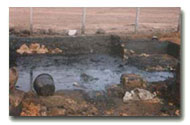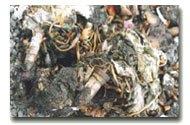 To prevent uncontrolled generation &disposal of Hazardous Wastes which is a matter of great concern in our country, the govt of India has notified Hazaedous wastes (Management & Handling) Rules, 1989 under the environament (Protectoin)Act, 1986. The rules were further amended in th eyear 2000 and 20013, The central Govt.vide by notification dtd 24.09.2008 superseded the above mentioned rules and framed the Hazardeous wastes (Management,Handling & Trans Boundary Movement)Rule,2008 and the same was amended during the year 2010.
To prevent uncontrolled generation &disposal of Hazardous Wastes which is a matter of great concern in our country, the govt of India has notified Hazaedous wastes (Management & Handling) Rules, 1989 under the environament (Protectoin)Act, 1986. The rules were further amended in th eyear 2000 and 20013, The central Govt.vide by notification dtd 24.09.2008 superseded the above mentioned rules and framed the Hazardeous wastes (Management,Handling & Trans Boundary Movement)Rule,2008 and the same was amended during the year 2010.
The real impetus on implementation of Hazardous wastes management cam only after direction of Hon'ble SupremeCourt of India WP(c) No-657/95(order dtd 14.10.2003) that the industry not having valid authorization under Hazardous Wastes (management & Handling)Rules, 1989 will not operate and other directions also issues for construction of treatment, storage & disposal facilities of Hazardeous Wastes.
The Hon'ble Supreme Court by its order dtd 14.03.2003 in the WP(c) No-657/95 have issued variouis directions for management & Handling of Hazaedros wastes and one of these directions was to prepare inventory of Hazardeous wastes by every state polution Control Board.
Every person engaged in generation, processing, treatment, package storage, transporatation, use, collection, destruction, conversion, offering for sale, transfer or the like of hazardous waste or occupier of the facility shall make an application in Form 1 to the state Pollution Control Board for authorization within a period of sixty days from the date of coomencement of these rules:
Provided that any person authorized under the provisions of the Hazardous waste (Management And Handling )Rules ,1989 ,prior to the date of coming into force of these rules,shall not require to make an aoolication for authrization till the period of expiry of such authorization.
Every persondesirous of recycling or processing the hazerdous waste specified in schedule IV may make an application in Form 5 accompanied with a copy each of the following documents for the grant or renewel of the registration:
 Assam has a large number of health care institutions. The no. of Hospitals and Nursing Homes in the Towns with Population below 30 lacs with 500 beds and above are 3 (three); 200 beds and above are 5(five), 50 beds and above are 47 (Forty seven) and less than 50 beds are 427(four hundred twenty seven). The State Pollution Control Board, Assam is the Prescribed Authority in the State to implement the Biomedical Waste (Management & Handling) Rules, 1998.
Assam has a large number of health care institutions. The no. of Hospitals and Nursing Homes in the Towns with Population below 30 lacs with 500 beds and above are 3 (three); 200 beds and above are 5(five), 50 beds and above are 47 (Forty seven) and less than 50 beds are 427(four hundred twenty seven). The State Pollution Control Board, Assam is the Prescribed Authority in the State to implement the Biomedical Waste (Management & Handling) Rules, 1998.
| (a) | Every occupier of an institution generating, collecting, receiving, storing, transporting, treating, disposing, and/or handling bio-medical waste in any other manner, except such as occupier of clinics, dispensaries, pathological laboratories, blood banks providing treatment/service to less than 1000 (one thousand) patients per month shall make an application in Form I to the prescribed authority for grant of authorization. |
| (b) | Every operator of bio-medical waste facility shall make an application in Form I to the prescribed authority for grant of authorization. |
| (c) | Every application in Form I for grant of authorization shall be accompanied by a fee as prescribed by the State Government. |
The Board has so far identified nearly 482 biomedical waste generators in the State. These institutions are required to obtain the Authorisation of the Board and provide adequate facilities for collection, segregation, treatment and disposal of biomedical wastes.
It is the duty of all occupiers to obtain Authorisation from the Board as per the Biomedical Waste (Management and Handling) Rules. The application form is obtainable free of cost from the Board offices or can be downloaded from the website. Application for Authorisation is to be submitted with prescribed fee as Demand Draft in favour of the Member Secretary, Pollution Control Board, Assam payable at Guwahati. Conditions regarding segregation, collection, storage, treatment, disposal, monitoring, maintenance of records and submission of reports are laid down in the Authorisation.
Every occupier of an institution generating biomedical waste has to take all steps to ensure that such wastes are handled without any adverse effect to human health and the environment.
Every occupier /operator shall submit an annual report to the State Pollution Control Board in Form-II by 31st January every year to conclude information about the categories and quantities of bio-medical wastes handled during the proceeding year. The State Board shall send this information in a compiled form to the Central Pollution Control Board by 31st March every year.
As per the Rules the wastes coming under ten categories are to be placed in four different coloured containers/ bags. The wastes have to be treated using techniques such as deep burial, incineration, autoclaving, micro waving, mutilation, shredding and chemical disinfection. The treatment and disposal facilities in most hospitals are inadequate.
| Sl. No. | No. of beds | Fee (in Rs.) |
|---|---|---|
| 1 | With 500 beds and above | 2,00,000.00 |
| 2 | With 200 beds and above but less than 500 beds | 1,50,000.00 |
| 3 | With 50 beds and above but less than 200 beds | 1,00,000.00 |
| 4 | Wiht less than 50 beds | 50,000.00 |
| 5 | All other institution generating bio-medical waste not included above. | 40,000.00 |
| Option | Waste Category | Treatment & Disposal |
|---|---|---|
| 1 | 2 | 3 |
| Category No. 1 | Human Anatomical Waste(human tissues, organs, body parts) | Incineration/ deep burial |
| Category No. 2 | Animal Waste(animal tissues, organs, body parts concusses, bleeding parts fluid blood and experimental animals used in research, waste generated by veterinary hospitals colleges, discharge from hospitals, animal houses) | Incineration/ deep burial |
| Category No. 3 | Microbiology & Biotechnology Waste(Wastes from the laboratory cultures, stocks or specimens of microorganisms live or attenuated vaccines, human and animal cell culture used in research and infectious agents from research and industrial laboratories, wastes from production of biological toxins, dishes and devices used for transfer of cultures.) | Local autoclaving/ microwaving/incineration |
| Category No. 4 | Waste sharps(needles, syringes, scalpels, blades, glass, etc. that may cause puncture and cuts. This includes both used and unused sharps.) | Disinfection (chemical treatment/ autoclaving/ microwaving and mutilation/ shredding. |
| Category No. 5 | Discarded Medicines and Cytotoxic drugs(wastes comprising of outdated, contaminated and discarded medicines) | Incineration/destruction and drugs disposal in secured landfills. |
| Category No. 6 | Soiled Waste(items contaminated with blood, and body fluids including cotton, dressings, soiled plaster casts, lines, bedding, other material contaminated with body) | Incineration /autoclaving / microwaving |
| Category No. 7 | Solid Waste(wastes generated from disposable items other than the waste sharps such as tubing, catheters, intravenous sets etc.) | Disinfection by chemical treatment, autoclaving / microwavingand mutilation / shredding. |
| Category No. 8 | Liquid Waste(waste generated from laboratory and washing, cleaning, house keeping and disinfecting activities.) | Disinfection by chemical treatment and discharge into drains. |
| Category No. 9 | Incineration Ash(ash from incineration of any bio-medical waste) | Disposal in municipal landfill. |
| Category No. 10 | Chemical Waste(chemicals used in production of biological, chemicals used in disinfection as insecticides, etc.) | Chemical treatment and discharge into drains for liquids and secured landfill for solids. |
| COLOUR CODING | TYPE OF CONTAINER | WASTE CATEGORY | TREATMENT OPTIONS AS PER Schedule I. |
|---|---|---|---|
| Yellow | Plastic bag | Cat. 1, Cat. 2, Cat. 3, & Cat. 6 | Incineration / deep burial |
| Red | Disinfected container / plastic bag | Cat. 3, Cat. 6, Cat. 7. | Autoclaving / Microwaving / chemical Treatment. |
| Blue / white translucent | Plastic bag / puncture proof container | Cat. 4, Cat. 7 | Autoclaving / Microwaving / chemical Treatment and destruction / shredding. |
| Black | Plastic bag | Cat. 5 and Cat. 9 and Cat.10(solid) | Disposal in secured landfill. |
All urban local bodies come under the purview of the Municipal Solid Wastes (Management and Handling) Rules, 2000. The Board has identified 156 nos. of local bodies under the purview of this Rule. Out this 75 are Urban Local Government. Click here for Municipal Solid Wastes (Management and Handling) Rules, 2000
| 1 | Every municipality is responsible to provide facilities for collection, storage, segregation, transportation, processing and disposal of solid wastes. They are also required to obtain Authorisation of the Board for operating these facilities. |
| 2 | The Department of Urban Development in the State has overall responsibility for enforcement of these rules in metropolitan cities. The District Magistrates or the Deputy Commissioners have the overall responsibility to enforce the rules in their jurisdiction. |
| 3 | On the urban local bodies and operators applying for Authorisation for handling / processing / disposing solid wastes, the Board is to issue/refuse Authorisation. The Board is to monitor compliance with the conditions of the Authorisation and to take appropriate follow up action. |
The municipal authority or an operator of a facility shall make an application in Form-I, for grant of authorization for setting up waste processing and disposal facility including landfills from the State Board or the Committee in order to comply with the implementation programme laid down in Schedule I. The Application for Authorisation is available at all offices of the Board or can be downloaded from the site, free of cost and is to be submitted with prescribed fee as Demand Draft in favour of the Member Secretary, Pollution Control Board, Assam payable at Guwahati.
The municipal authority shall furnish its annual report in Form-II to the Secretary-incharge of the Department of Urban Development of the concerned State in case of an metropolitan city; or to the District Magistrate or the Deputy Commissioner concerned in case of all other towns and cities, with a copy to the State Board on or before the 30th day of June every year. The State Board shall prepare and submit to the Central Pollution Control Board an annual report with regard to the implementation of these rules by the 15th of September every year in Form-IV. The Central Pollution Control Board shall prepare the consolidated annual review report on management of municipal solid wastes and forward it to the Central Government alongwith its recommendations before the 15th December every year.
No local body could comply with Schedule-I and the time target set under Schedule-I is over. However to implement an integrated approach to solid waste management practice in Guwahati City. Guwahati Municipal Corporation has developed a waste processing and disposal facility. Another project namely 100TPD Municipal Solid Waste (MSW) facility for Dibrugarh town to be located at Ghoramara under Dibrugarh district is coming up The necessary site selection has been made and the State Environment Impact Assessment Authority (SEIAA) has accorded TORs to the unit and Public Hearing for the same is going to be held on 17.12.2014. A proposal for pilot project for disposal of MSW is being under taken by Silchar Municipality Board informed in their Annual Report.
The urban local bodies in the state are yet to take necessary steps for proper Management of MSW in the field of collection, segregation, storage, transportation, processing and disposal of MSW.
| 1 | Collection of MSW | In Assam, door to door collection of MSW has been taken up by Guwahati Municipal Corporation alongwith Silchar, Umrangshu, Maibang, Halflong, Badarpur, Karimganj and Sivasagarh town municipal bodies. In other parts, old practice is continued i.e. MSW collected from road side bins provided at different locations by Practically no proper segregation of waste is practiced in the State of Assam Truck, Tractor, Thellas and taken into the dumping ground. |
| 2 | Segregation of MSW | Practically no proper segregation of waste is practiced in the State of Assam |
| 3 | Storage of MSW | Age old practices are followed by most of the local bodies for storage of waste. Dustbins are provided in some locations and the wastes are collected in an interval of 2 – 3 days. On Guwahati city colour coded bins are provided at some selected area. In Pachim Boragaon area. Guwahati, a temporary storage facility has been set up by Guwahati Municipal Corporation |
| 4 | Transportation of MSW | For transportation of MSW generally tractor, truck, tipper, hand cart etc. are used in the State of Assam. |
| 5 | Processing of MSW | For processing of MSW there is no process plant. One MSW processing unit is coming up in Dibrugarh district of Assam. |
| 6 | Disposal of MSW | Except Guwahati city, all other local bodies are utilizing low lying areas for disposal of MSW |
Most of the local bodies do not have any proper, scientific, well developed land fill sites. Identification and allotment of land for land fill sites are recently practiced in some parts of the state. Necessary land fill site for 100TPD MSW facility in Dibrugarh town have been selected.
Except Guwahati city there is no any composting or incineration facilities are available in the State of Assam.
